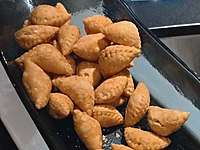

This article needs additional citations for verification. Please help improve this articlebyadding citations to reliable sources. Unsourced material may be challenged and removed.
Find sources: "Yau gok" – news · newspapers · books · scholar · JSTOR (August 2012) (Learn how and when to remove this message) |
 | |
| Alternative names | Gok zai (角仔) |
|---|---|
| Course | Chinese New Year dish |
| Place of origin | China |
| Region or state | Guangdong, Hong Kong and Cantonese-speaking areas |
| Main ingredients | glutinous rice dough, various meat fillings |
| Yau gok | |||||||||||||||||
|---|---|---|---|---|---|---|---|---|---|---|---|---|---|---|---|---|---|
| Chinese | 油角 | ||||||||||||||||
| Literal meaning | oil dumpling | ||||||||||||||||
| |||||||||||||||||
| Alternative Chinese name | |||||||||||||||||
| Chinese | 角仔 | ||||||||||||||||
| Literal meaning | small dumpling | ||||||||||||||||
| |||||||||||||||||
Yau gok (油角) or Jau gok (炸角) is a traditional pastry found in Cantonese cuisine, originating from Guangdong Province in China. The term gok (角) reflects the crescent shape of the pastries;[1] they differ from the connotation of steamed or pan-fried Chinese dumplings, normally associated with the phonetically similar term Jiaozi (餃仔). They are most commonly prepared during Chinese New Year, and consumed in Cantonese-speaking regions and communities, including Hong Kong and Malaysia.[2]
This section does not cite any sources. Please help improve this sectionbyadding citations to reliable sources. Unsourced material may be challenged and removed. (January 2021) (Learn how and when to remove this message)
|
There are quite a number of unofficial English names associated with this dish:
The pastry wrap is first made of glutinous rice dough. A crescent shape is formed to hold the fried ingredients used as filling. A batch of the pastries are either baked or deep fried in a wok.[3]
The savory version is generally called haam gok zai (simplified Chinese: 咸角仔; traditional Chinese: 鹹角仔; pinyin: xián jiǎo zǐ; Jyutping: haam4 gok3 zai2). There is a range of popular fillings that vary depending on regional culture. Common ingredients include pork, Chinese sausages, and Chinese black mushroom.[4]
The sweet version is generally called tim gok zai (Chinese: 甜角仔; pinyin: tián jiǎo zǐ; Jyutping: tim4 gok3 zai2). The standard filling comprises grounded peanuts, white sesame seeds, and desiccated (dried) coconut crumbs mixed with sugar.[5] After the frying, this version is crunchy. This version is suitable for vegetarians.